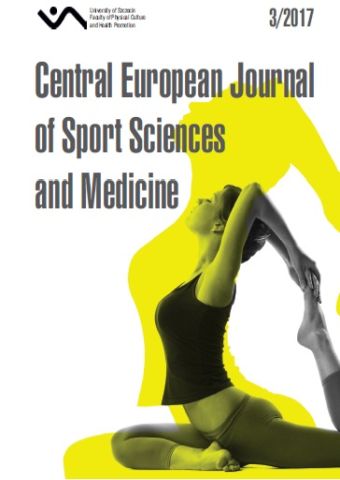
ISSN: 2300-9705
eISSN: 2353-2807
OAI
DOI: 10.18276/cej.2017.3-05




Lista wydań /
Vol. 19, No. 3/2017
Underrepresentation of Women in Sports Organizations. Polish, British and International Organizations – a Comparative Analysis
| Autorzy: |
Natalia
Organista
Józef Piłsudski University of Physical Education, Department of Humanities and Social Sciences, Poland |
| Słowa kluczowe: | British Polish equality gender international sport organisations sport organisations |
| Data publikacji całości: | 2017-09 |
| Liczba stron: | 12 (55-66) |
Abstrakt
From feminist and critical point of view sport has been a sexist institution. Despite the women empowerment in sport they are still trivialized and marginalized. Research also shows that sport organizations may be exceptionally opposed to women, valuing hegemonic masculinity. Therefore the aim of this article is to check whether gender inequalities occur in Polish sports organizations and what is the scale of those inequalities in comparison to international and British organizations. The study used methods of examining official documents (information generated by other empirical data from official documents of the organisation). The sample consists of 17 Polish, 17 international and 17 British sports organisations. The results of research showed that in Polish sports organisations there are working less women than in the international and British organisations, there are also less women in committees and women committees (if they have been established). More women work in organisations which represent women-orientated sports disciplines.
Pobierz plik
Plik artykułu
Bibliografia
| 1. | Acker, J. (1992). Gendering organizational theory. In: A. Mills, P. Tancred (eds.), Gendering organizational analysis (pp. 248-260). London: Sage. |
| 2. | Acker, J. (1990). Hierarchies, jobs, bodies. A Theory of gendered organizations. Gender and Society, 4 (2), 139–158. DOI: 10.1177/089124390004002002. |
| 3. | Alvesson, M., Billing, Y. (1997). Understanding gender and organizations. London: Sage. |
| 4. | Anderson, E. (2009). The maintenance of masculinity among the stakeholders of sport. Sport Management Review, 12 (1), 3–14. DOI: 10.1016/j.smr.2008.09.003. |
| 5. | Babbie, E. (2009). Podstawy badań społecznych, Warszawa: Wydawnictwo Naukowe PWN. |
| 6. | Connell, R. (2001). Masculinities. Cambridge: Polity Press. |
| 7. | Claringbould, I., Knoppers, A. (2012). Paradoxical practices of gender in sport-related organizations. Journal of Sport Management, 26 (5), 404–416. |
| 8. | From Kumamoto to Sydney. Women and sport progress report 2006-20010 (2014, January 10). Retrieved from: http:// sydneyscoreboard. com/conference/IWG_progress_report.pdf. |
| 9. | Hall, A. (2002). The discourse of gender and sport: from femininity to feminism. In: S. Scraton, A. Flintoff (eds.), Sport and gender. A reader. New York: Routledge. |
| 10. | Hoeber, L. (2007). Exploring the gaps between meanings and practices of gender equity in sport organization. Gender, Work and Organization, 14 (3): 259–280. DOI: 10.1111/j.1468-0432.2007.00342.x. |
| 11. | Jakubowska, H. (2014). Gra ciałem. Praktyki i dyskursy różnicowania płci w sporcie. Warszawa: Wydawnictwo Naukowe PWN. |
| 12. | Kay, T. (2003). Women, sport and gender inequality. In: B. Houlihan (ed.), Sport and society. A student introduction (pp. 130–155). London: Sage. |
| 13. | Koivula, N. (2001). Perceived characteristics of sports categorized as gender-neutral, feminine and masculine. Journal of Sport Behavior, 24 (4), 377–393. |
| 14. | Knoppers, A. (2010). Giving meaning to sport involvement in managerial work. Gender, Work and Organization, 18 (1), 1–22, DOI: 10.1111/j.1468-0432.2009.00467.x. |
| 15. | Łuczewski, M., Łuczewska-Bednarz, P. (2012). Analiza dokumentów zastanych. In: D. Jemielniak (ed.), Badania jakościowe. Metody i narzędzia (vol. 2, pp. 163–185). Warszawa: Wydawnictwo Naukowe PWN. |
| 16. | McKay, J., Messner, M., Sabo, D. (2006). Studying sport, men and masculinities from feminist perspective. In: J. McKay, M. Messner, D. Sabo (eds.), Masculinities, gender relations and sport (pp. 1–12). London: Sage. |
| 17. | Messner, M. (1992). Power at play: Sport and the problem of masculinity. Boston: Beacon Press. |
| 18. | Messner, M., Sabo, D. (1994). Sex, violence and power in sport: Rethinking masculinity. Crossing Press. |
| 19. | Pfister, G., Radtke, S. (2006). Dropping out: Why male and female leaders in German sports federations break off their careers. Sport Management Review, 9, 111–139. |
| 20. | Pfister, G., Radtke, S. (2009). Sport, women and leadership: results of a project on executives in German organizations. European Journal of Sport Science, 9 (4), 229–243. |
| 21. | Pawlak, A. (1998). Sprawozdanie z badań nt. Status polskiej manager-woman sportu. In: A. Pawlak (ed.), Polska manager-woman sportu (pp. 7–14). Warszawa, Kraków: Polskie Stowarzyszenie Sportu Kobiet. |
| 22. | Powell, G., Butterfield, A., Parent, J., (2000). Gender and managerial stereotypes: Have the times changed? In: M. Karsten (ed.). Gender, race and ethnicity in the workplace. Issues and challenges for today’s organizations (vol. 2, pp. 143–163). Westport: Praeger Publishers. |
| 23. | Sartore, M., Cunningham, B. (2007). Explaining the under-representation of women in leadership positions of sport organization: a symbolic interactionist perspective. Quest, 59, 244–265. DOI: 10.1080/00336297.2007.10483551. |
| 24. | Sibson, R. (2010). „I was banging my head against a brick wall”: Exclusionary power and the gendering of sport organizations. Journal of Sport Management, 24 (4): 379–399. |
| 25. | Skirstad, B. (2009). Gender policy and organizational change: A contextual approach. Sport Management Review, 12, 202–216. |
| 26. | Trophy Women? NGB Leadership Audit 2014 (2014). Retrieved from: http://www.wsff.org.uk/system/1/assets/files/000/001/640/1640/ cf1acd74f/original/Trophy_Women_Report_2014_final.pdf (10.01.2014). |
| 27. | Trophy Women? NGB Leadership Audit 2013 (2014). Retrieved from: http://www.wsff.org.uk/system/1/assets/files/000/000/474/ 474/49193d130/original/Trophy_Women_2013.pdf (10.01.2014). |